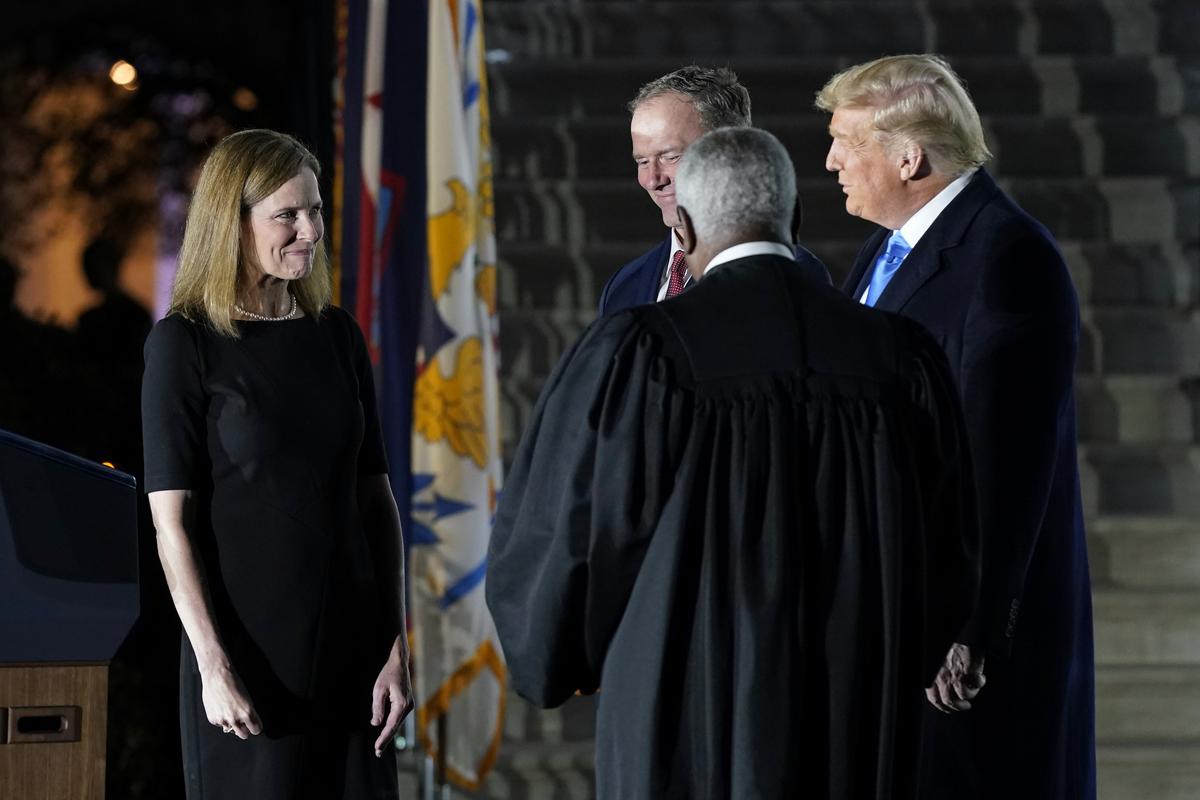 US President Donald Trump watches as Supreme Court Justice Clarence Thomas finishes administering the Constitutional Oath to Amy Coney Barrett on the South Lawn of the White House in Washington, Oct 26, 2020, after Barrett was confirmed by the Senate earlier in the evening. (PATRICK SEMANSKY / AP)
US President Donald Trump watches as Supreme Court Justice Clarence Thomas finishes administering the Constitutional Oath to Amy Coney Barrett on the South Lawn of the White House in Washington, Oct 26, 2020, after Barrett was confirmed by the Senate earlier in the evening. (PATRICK SEMANSKY / AP)
WASHINGTON - A divided US Senate voted mostly along party line Monday to confirm Judge Amy Coney Barrett, President Donald Trump's nominee, to the Supreme Court, succeeding late Justice Ruth Bader Ginsburg.
Since Trump announced the nomination of Amy Coney Barrett in late September, Democrats have consistently opposed the Senate move to confirm her, citing the proximity to Election Day, which is now just eight days away. They have insisted that the winner of the election be allowed to decide who fills the vacant seat
With 52 votes in favor and 48 against, the Republican-controlled Senate's confirmation of the 48-year-old conservative judge to the high court drew opposition from all of the Democratic members in the chamber.
Susan Collins, Republican senator from Maine who faces a tough reelection battle, was the only GOP senator who crossed the political aisle to side with the Democrats.
The confirmation made Barrett, a devout Catholic and longtime law professor at Notre Dame University, the 115th justice of the Supreme Court and the fifth woman ever to sit on the bench.
ALSO READ: Barrett edges closer to court confirmation
Shortly after the Senate vote, Justice Clarence Thomas administered Barrett's Constitutional oath during a nighttime ceremony presided over by Trump on the South Lawn of the White House.
"The oath that I've solemnly taken tonight, means at its core that I will do my job without any fear or favor and that I will do so independently of both the political branches and of my own preferences," said Barrett after her swearing-in.
Barrett was previously a judge on the Chicago-based Seventh Circuit Court of Appeals. Her installation on the Supreme Court to serve what will potentially be a lifelong tenure will further consolidate the conservative majority on the bench, giving Republican appointees a 6-3 edge over those picked by Democratic presidents.
Moments before Barrett took the oath, Trump, while expressing his confidence in Barrett's ability to "issue rulings based solely upon a faithful reading of the law and the Constitution" told her in a speech that "the American people put their trust in you and their faith in you as you take up the task of defending our laws, our Constitution and this country we all love."
Chief Justice John Roberts, also a Republican appointee, will administer the judicial oath of Barrett at the Supreme Court Tuesday, according to a news release from the Supreme Court, which said the newly approved justice will then "be able to begin to participate in the work of the Court."
ALSO READ: Trump nominates Barrett for US Supreme Court
Since Trump announced the nomination in late September, Democrats have consistently opposed the Senate move to confirm Judge Barrett, citing the proximity to Election Day, which is now just eight days away. They have insisted that the winner of the election be allowed to decide who fills the vacant seat.
Democrats accused Republicans of being hypocritical because they, relying on their majority status in the Senate, shot down then-President Barack Obama's Supreme Court nominee, Merrick Garland, in 2016, also an election year.
Despite the boycott from Democrats, Senate Republicans pushed for a swift confirmation process for Barrett, arguing for her eligibility for the job and that their move is justified because now, unlike four years ago, the same party controls the White House and the Senate.


